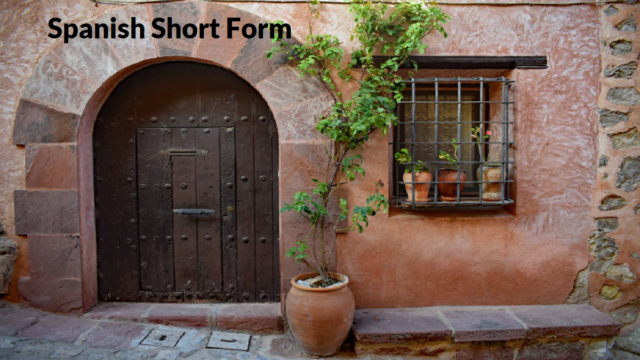Table of Contents
What is Spanish Short Form in English?
Spanish short form is Spa or Span.
When it comes to languages that have influenced and captivated millions of people around the world, Spanish undoubtedly stands out. From its rich history to its widespread use across continents. This Romantic language has left an indelible mark on global culture. We will delve into the origins, characteristics, and global impact of the Spanish language.
Origins of the Spanish Language
The Spanish language, or español, as it is commonly known, has its roots in the Latin spoken by the Romans during their conquest of the Iberian Peninsula around 2,000 years ago. Over time, this Latin evolved, merging with the local languages spoken by the inhabitants of the region, such as Celtiberian and Basque. The result was a new language known as Vulgar Latin, which eventually transformed into the Spanish language we know today.
Evolution and Development
Spanish, as a Romance language, shares similarities with other languages derived from Latin, such as Italian, French, Portuguese, and Romanian. Over the centuries, Spanish has evolved through various stages, including Old Spanish (9th-15th centuries), Middle Spanish (15th-17th centuries), and Modern Spanish (18th century onwards). During these periods, the language underwent significant changes in vocabulary, pronunciation, and grammar.
Spanish Alphabet and Pronunciation
The Spanish alphabet consists of 27 letters, including the addition of the letter “ñ” (eñe), which is unique to the language. Unlike English, Spanish pronunciation is generally straightforward and phonetic, making it relatively easier for learners to grasp. However, certain phonetic nuances, such as the trilled “r” sound and the distinct pronunciation of “ll” and “y,” may require some practice for non-native speakers.
Grammar and Sentence Structure
Spanish grammar follows a consistent set of rules, making it more structured and predictable compared to some other languages. Nouns are gendered as masculine or feminine, and adjectives must agree with the gender and number of the noun they modify. Verbs are conjugated based on the subject, tense, and mood, which can be a bit challenging for beginners but becomes intuitive with practice.
Spanish Varieties and Dialects
As Spanish spread across the globe during the era of exploration and colonization, it adapted to the linguistic influences of different regions. This led to the development of various Spanish varieties and dialects, each with its own unique characteristics. Some notable varieties include Mexican Spanish, Castilian Spanish, Argentine Spanish, Colombian Spanish, and many more. While they share a common foundation, dialectal differences may include vocabulary, pronunciation, and idiomatic expressions.
Spanish as a Global Language
Spanish is one of the most widely spoken languages in the world, with approximately 460 million native speakers. It is the official language of 21 countries, including Spain, Mexico, Colombia, Argentina, and Peru. Moreover, it is the second most spoken language in terms of total number of speakers, with many individuals learning Spanish as a second language for professional, academic, or personal reasons.
Cultural and Artistic Influence
Beyond its linguistic significance, the Spanish language has played a pivotal role in shaping global culture. Spanish literature boasts a wealth of renowned authors, from Miguel de Cervantes and Gabriel García Márquez to Federico García Lorca and Isabel Allende. Spanish cinema has also made a profound impact, with directors like Pedro Almodóvar and Guillermo del Toro receiving international acclaim. The expressive nature of the language itself lends itself to passionate poetry, captivating music, and captivating music, and vibrant dances such as flamenco and salsa. Spanish-speaking countries have contributed immensely to the world of art, architecture, and gastronomy as well. From the majestic works of Antoni Gaudí in Barcelona to the delectable flavors of paella and empanadas, Spanish culture has left an indelible imprint on the global stage.
Spanish as a Business Language
In today’s interconnected world, proficiency in Spanish opens doors to countless opportunities in business and trade. Spanish-speaking countries, particularly those in Latin America, are experiencing significant economic growth, making them attractive markets for international businesses. Being able to communicate effectively in Spanish not only facilitates negotiations and collaborations but also demonstrates cultural sensitivity and respect, which are highly valued in global business settings.
Learning Spanish: Benefits and Resources
With the increasing importance of Spanish in various aspects of life, learning the language has become a valuable asset. Whether you are a student, a traveler, or a professional, acquiring Spanish language skills can enhance your personal and career prospects. Fortunately, there are numerous resources available to help you on your language-learning journey. From online courses and mobile apps to language exchange programs and immersion experiences, the options are abundant, making it easier than ever to embark on your quest to master Spanish.
Preserving and Promoting Spanish
As with any language, the preservation and promotion of Spanish are crucial to ensuring its vitality for future generations. Efforts are being made to protect regional variations and dialects, as well as to promote Spanish education in schools worldwide. Organizations such as the Instituto Cervantes and the Real Academia Española play a pivotal role in standardizing and promoting the Spanish language, while cultural events and celebrations further contribute to its recognition and appreciation.
Conclusion
The Spanish language is a treasure trove of history, culture, and global influence. From its humble origins in the Latin spoken by the Romans to its widespread usage across continents, Spanish has captivated the hearts and minds of millions. Its evolution, grammar, and pronunciation make it a fascinating language to learn, while its cultural impact extends to literature, cinema, art, and more. With its growing importance in business and trade, learning Spanish opens up a world of opportunities. So, whether you are enticed by its beauty or driven by practical reasons, embracing the Spanish language will undoubtedly enrich your life in numerous ways.








